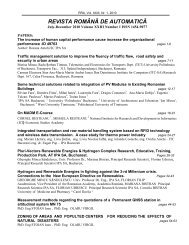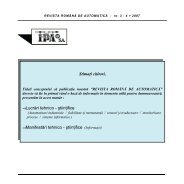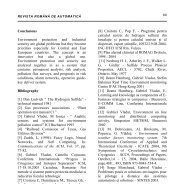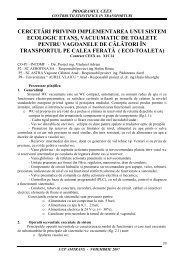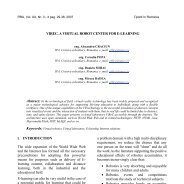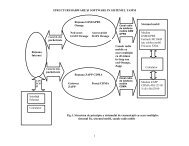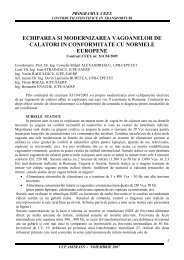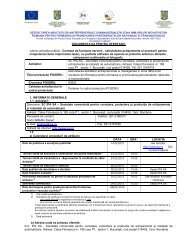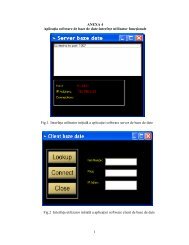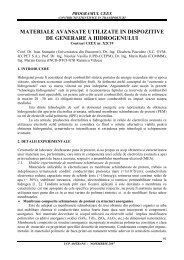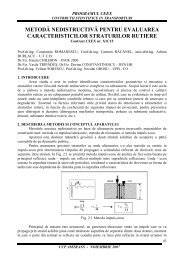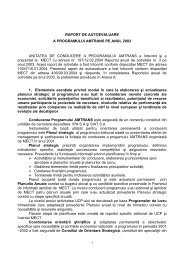REVISTA ROMÃNÄ DE AUTOMATICÄ - IPA SA
REVISTA ROMÃNÄ DE AUTOMATICÄ - IPA SA
REVISTA ROMÃNÄ DE AUTOMATICÄ - IPA SA
Create successful ePaper yourself
Turn your PDF publications into a flip-book with our unique Google optimized e-Paper software.
<strong>REVISTA</strong> ROMÂNĂ <strong>DE</strong> AUTOMATICĂ<br />
13<br />
New Trends in the Web Evolution<br />
(The Emergence of the Web)<br />
Luigi Gabriel CERBAN, Alexandru BOTU, Adrian BADOIU<br />
SC <strong>IPA</strong> <strong>SA</strong>- Bucharest, Romania, luigi@ipa.ro<br />
Abstract: Predicting the future is always a dicey business, and never more so than when the subject is<br />
the Web. The Web has been evolving so quickly that some say one Web year is the equivalent of three real<br />
years. Progress in communication technology has been characterized by a movement from lower to<br />
higher levels of abstraction. The Semantic Web is not just for the World Wide Web. It represents a set of<br />
technologies that will work equally well on internal corporate intranets. This is analogous to Web<br />
services representing services not only across the Internet but also within a corporation's intranet. So, the<br />
Semantic Web will resolve several key problems facing current information technology architectures.<br />
Key words: The Semantic Web, Web of trust, Mobile Web<br />
I. INTRODUCTION<br />
II.<br />
WHAT IS THE SEMANTIC WEB?<br />
"The first step is putting data on the Web in a<br />
form that machines can naturally understand, or<br />
converting it to that form. This creates what I<br />
call a Semantic Web-a web of data that can be<br />
processed directly or indirectly by machines."[7]<br />
The future of the Web lies first with the<br />
convergence of the semantic Web, Web of trust<br />
and Web 2.0, followed by twinning with GRIDs.<br />
This e-infrastructure will allow more or less<br />
unlimited access to information, business<br />
processing, entertainment, education, research<br />
and so forth. [4]<br />
The Semantic Web provides a common<br />
framework that allows data to be shared and<br />
reused across application, enterprise, and<br />
community boundaries. Can think of the<br />
Semantic Web as an efficient way to<br />
represent data on the World Wide Web, or as<br />
a database that is globally linked, in a manner<br />
understandable by machines, to the content of<br />
documents on the Web. Semantic<br />
technologies represent meaning using<br />
ontologies and provide reasoning through the<br />
relationships, rules, logic, and conditions<br />
represented in those ontologies.<br />
It is a collaborative effort led by W3C with<br />
participation from a large number of researchers<br />
and industrial partners. It is based on the<br />
Resource Description Framework (RDF).<br />
Semantic Web aims to assist the web users to<br />
contribute information in ways that<br />
computers can understand, process and<br />
exchange. This will enable the web<br />
applications to perform tedious task of<br />
collating information from varied sources.<br />
And also assist users to find relevant<br />
information, such as, a movie review,<br />
scholarship posting for specific students, a<br />
book order, etc., quickly. The Semantic Web<br />
applications will use languages like Resource<br />
Description Framework (RDF), Extensible<br />
Markup Language (XML), XML Schema and<br />
RDF Vocabulary Description Language 1.0:<br />
RDF Schema (RDFS).<br />
Tim Berners-Lee, James Hendler and Ora<br />
Lassila unveiled a nascent vision of the<br />
Semantic Web: a highly interconnected<br />
network of data that could be easily accessed<br />
and understood by any desktop or handheld<br />
machine. [3] They painted a future of<br />
intelligent software agents that would head



